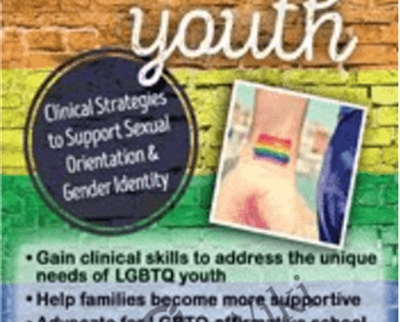LGBTQ Youth: Clinical Strategies to Support Sexual Orientation and Gender Identity – Deb Coolhart
 Recently, the LGBTQ community has been in the national spotlight for challenging issues like which bathroom a transgender person should use, increased youth suicide rates, and the Pulse nightclub tragedy.
Recently, the LGBTQ community has been in the national spotlight for challenging issues like which bathroom a transgender person should use, increased youth suicide rates, and the Pulse nightclub tragedy.
LGBTQ Youth: Clinical Strategies to Support Sexual Orientation and Gender Identity by Deb Coolhart,
Salepage link: At HERE. Archive:
Recently, the LGBTQ community has been in the national spotlight for challenging issues like which bathroom a transgender person should use, increased youth suicide rates, and the Pulse nightclub tragedy. No wonder youth in our communities are scared to be open about who they are.
As a clinician, how are you supposed to help an LGBTQ youth when their parents are just not on board? Also as a clinician, do you know what type of treatment techniques to suggest when a transgender youth wants to prolong hitting puberty? These are the types of questions clinicians struggle with.
Join expert and author, Deb Coolhart, Ph.D., LMFT as she draws on her nearly 20 years of working with LGBTQ youth. Deb will show you effective clinical strategies for:
- Coming out
- Bullying
- Suicide, anxiety, shame, depression, self-harming
- Making healthy choices
- Thriving in school
- Options for guiding gender transition
Working with these youth and families can be complex, requiring the balance of many seemingly opposing viewpoints. As a clinician, there is nothing more rewarding than facilitating these changes and watching families discover their own path towards understanding.
Help LGBTQ kids and adolescents know that it’s their right to be themselves!
- Assess how school, family and social pressures impact the formation of an LGBTQ youth’s identity.
- Support the coming out process with youth clients and facilitate family interventions to create safety, support, space, and acceptance.
- Analyze LGBTQ youth clients’ level of risk and protective factors for developing symptoms of anxiety and depression, as well as self-harm behaviors and suicidal ideation.
- Assess family dynamics of the client to determine potential to work towards increased acceptance and support.
- Assist transgender clients in the readiness process for medical gender transition and compose letters of support for clients to obtain medical gender transition treatments.
- Foster LGBTQ affirmative school environments with strategies for working in conjunction with school staff, administration and parents.
Coming Into an LGBTQ Identity and Coming Out to Others
- Identity development
- Internalized homo-bi-trans-phobia
- The decision to come out
- Fears in the coming out process
- Youths’ safety
Clinical Considerations
- Intervening in depression, shame, self-harming behaviors, and suicidality
- Addressing anxiety
- Approaching transgender compared to LGBQ
- Importance of family acceptance
- Intersections of other cultural identities
-
Research limitations and risks of psychotherapeutic approaches
Differences within the LGBTQ Spectrum
- Lesbian Youth
- Confronting invisibility
- Facilitating positive self-esteem
- Gay Youth
- Discussing gender role expectations
- Sexual health
- Substance use
- Bisexual Youth
- Understanding bisexuality as a legitimate identity
- Harmfulness of bisexual erasure
- Transgender Youth
- Assessing need/desire for gender transition
- Exploring options for gender expression
- Questioning Youth
- Making space for exploration and fluidity
- Reducing pressure to self-label
Working with Families
- Coming Out
- Creating space for parents’ reactions and resistance
- Supporting youths’ LGBTQ identity
- Helping parents work towards increased acceptance and support
- Navigating religious beliefs
- Supporting parents’ own process of coming out
- Attending to the needs of siblings and extended family members
- Facilitating support networks
LGBTQ-Affirmative School Environments
- Importance of safe schools for youths’ well-being
- Assisting parents with school advocacy
- Coaching youth towards self-advocacy
- Dealing with bullying and mistreatment
- Considerations for transgender youth